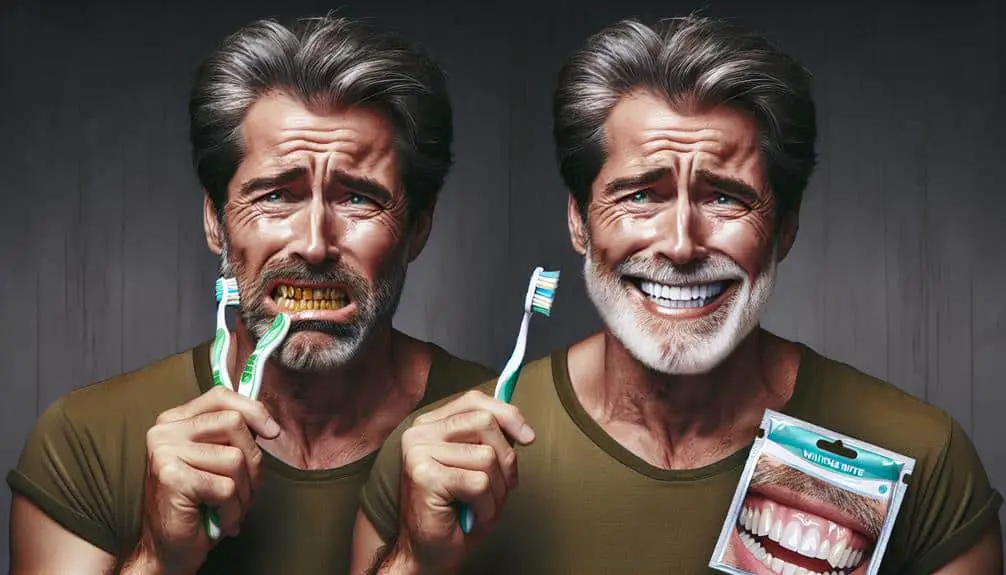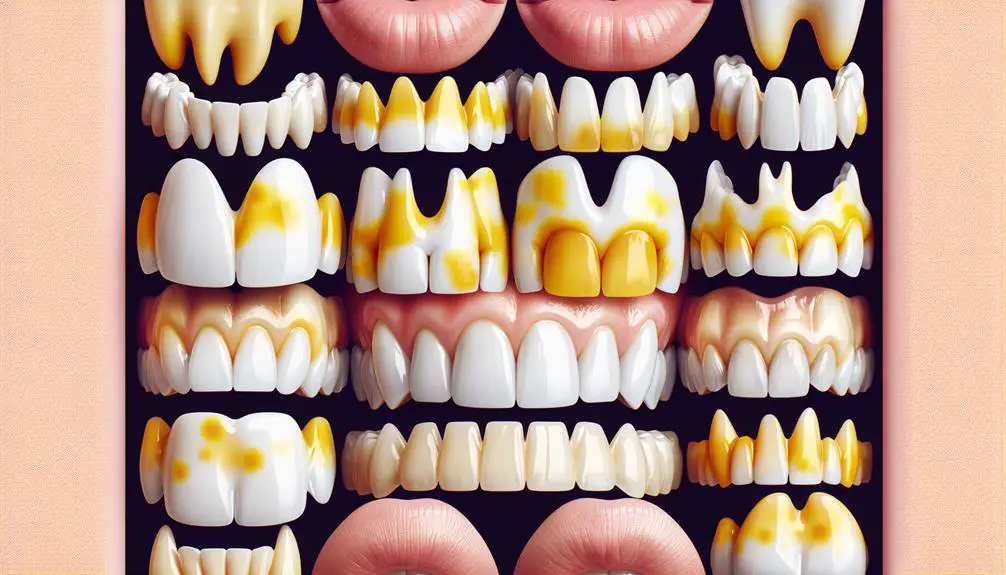When you take medications like tetracycline or iron during tooth development, the drugs can bind to your growing teeth, causing stains that last. These stains develop because the drugs interfere with the normal formation of tooth enamel, resulting in discoloration. If you want to understand more about why medications lead to tooth staining and how to prevent it, keep exploring tips on how to maintain the whiteness of your teeth and care for your oral health effectively.
Key Points
- Medications like tetracycline can bind to calcium in teeth, causing discoloration.
- Antibiotics like doxycycline can lead to yellow or gray stains on teeth.
- High iron supplements can result in dark stains on teeth.
- Antihistamines and antipsychotic medications can cause teeth staining.
- Chemotherapy drugs can discolor teeth due to their impact on tooth development.
Choosing the Right Whitening Products
To effectively whiten teeth after medication treatment, it's essential to carefully select the right whitening products for best results. When choosing whitening products, options like whitening toothpaste and strips can be effective for mild discoloration. Whitening toothpaste typically contains mild abrasives or gentle polishing agents to remove surface stains.
Whitening strips, on the other hand, are thin, flexible plastic strips coated with a whitening gel containing peroxide. These strips conform to the shape of your teeth and work by bleaching stains on the front and sides of teeth.
For more stubborn or deep stains, professional bleaching treatments may be necessary. Professional bleaching can be done in-office or at home using custom trays made by your dentist. In-office treatments often involve stronger bleaching agents and specialized equipment to accelerate the whitening process, while at-home trays offer a more gradual but still effective whitening solution.
Choosing the right whitening products tailored to your specific needs is vital in achieving a brighter, whiter smile post-medication treatment.
Adopting Proper Oral Hygiene Practices
When considering effective whitening methods post-medication treatment, incorporating proper oral hygiene practices is key to maintaining a bright and healthy smile. Brushing techniques play an important role in preventing staining caused by medications. Make sure you're using a soft-bristled toothbrush and brushing in gentle, circular motions to remove plaque and prevent discoloration. Pay attention to areas that are prone to staining, such as the back of your teeth and near the gumline.
In addition to brushing, flossing benefits can't be overstated. Flossing helps remove food particles and plaque from between your teeth and along the gumline, areas that brushing alone may not reach. By flossing daily, you can prevent the buildup of stains and maintain the overall health of your teeth and gums.
Remember that adopting proper oral hygiene practices isn't only essential for maintaining a white smile but also for promoting good oral health. Consistency in your brushing techniques and flossing routine will go a long way in preventing medication-induced stains.
Regular Dental Check-ups
Routine dental check-ups are essential for monitoring your oral health and addressing any issues before they develop into larger problems. During these check-ups, your dentist can provide professional cleanings to remove plaque and tartar buildup that regular brushing may miss. Additionally, dentists can assess your overall oral health, including checking for signs of tooth decay, gum disease, or other issues that could lead to teeth staining.
Regular dental check-ups also offer the opportunity to discuss the benefits of fluoride in preventing tooth decay and strengthening enamel. Fluoride treatments provided during these visits can help protect your teeth and reduce the risk of staining caused by medication or other factors.
When considering the financial aspect, it's important to note that dental insurance often covers routine check-ups, making it more affordable to maintain your oral health. By utilizing your dental insurance for these visits, you can stay proactive in preventing stains and other dental issues. Remember, prevention is key to keeping your smile bright and healthy.
Avoiding Stain-Causing Foods and Drinks
Limiting consumption of stain-causing foods and drinks can help preserve the brightness of your teeth and prevent discoloration. Certain foods and beverages have the potential to stain your teeth over time, compromising their whiteness. To maintain a bright smile, consider reducing your intake of items such as coffee, tea, red wine, and dark-colored berries.
Acidic foods like citrus fruits can also weaken enamel, making teeth more susceptible to staining. If you do consume these foods or drinks, consider rinsing your mouth with water afterwards to help minimize their staining effects. Additionally, incorporating teeth-whitening products into your oral care routine can help counteract the discoloration caused by certain foods.
When making diet choices, opt for foods that promote overall oral health, such as crunchy fruits and vegetables that can help scrub away plaque. By being mindful of your diet and making strategic choices, you can support teeth whitening efforts and maintain a bright, healthy smile.
Managing Stress for Oral Health
To maintain peak oral health, managing stress levels is vital as it can impact various aspects of your dental well-being. Stress can lead to oral health issues such as teeth grinding, gum disease, and poor oral hygiene habits. Incorporating relaxation techniques into your daily routine can help alleviate stress and promote better oral health.
Mindful eating is also important as it not only aids in stress reduction but can also benefit your teeth and gums. When you're stressed, you may be more prone to consuming sugary or acidic foods that can harm your teeth. By practicing mindful eating, you can make healthier food choices that support your oral health.
Relaxation techniques such as deep breathing exercises, meditation, or yoga can help reduce stress levels and improve your overall well-being, including your oral health. By incorporating these practices into your daily routine, you can better manage stress and protect your teeth and gums from the negative impacts of stress.
Frequently Asked Questions
Can Teeth Staining After Medication Treatment Be Reversed or Prevented?
To prevent teeth staining after medication treatment, focus on good oral hygiene practices like brushing and flossing regularly. Reversal techniques may involve professional dental cleanings and whitening treatments. Consult your dentist for personalized advice on maintaining a bright smile.
Are There Any Alternative Treatments or Medications That Do Not Cause Teeth Staining?
To avoid teeth staining, explore natural remedies and preventive measures. Dietary changes and impeccable oral hygiene can aid in maintaining teeth whiteness. Consider alternatives and medications that do not typically cause staining for a brighter smile.
How Long Does It Typically Take for Teeth Staining to Occur After Starting Medication Treatment?
Typically, teeth staining can start within a few weeks of beginning certain medication treatments. To prevent this, maintain good dental care habits like brushing and flossing regularly. Be aware of the potential effects medications may have on your teeth.
Are Certain Types of Medications More Likely to Cause Teeth Staining Than Others?
When it comes to teeth staining from medications, some types pose a higher risk. Dentist recommendations, dietary habits, and oral hygiene play pivotal roles in protecting enamel. Stay mindful and proactive for a brighter smile.
Are There Any Specific Steps or Precautions One Can Take to Minimize Teeth Staining While on Medication Treatment?
To minimize teeth staining while on medication treatment, focus on impeccable dental hygiene. Brush and floss regularly, and consider using a whitening toothpaste. Be cautious with staining foods and drinks, and discuss any concerns with your dentist.



